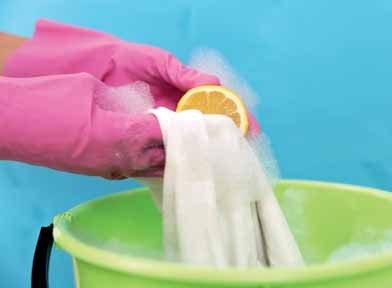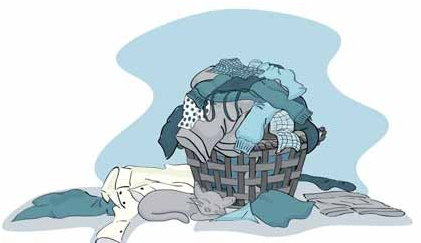If you were to try to define the human experience, you might focus on the everyday occurrences that unite us all with shared understanding and emotions, no matter where or how we live. To name just a few: the exhilaration of hearing live music, the satisfaction that comes after eating a well- cooked meal, the wonder of encountering a breathtaking view of our planet’s natural beauty…and, unfortunately, odors stuck in our fabrics…
There’s some comfort in knowing no one can escape the global problem of stubborn odors in textiles. Prince or pauper, it is truly a shared human experience. In fact, consumers around the world spend upwards of $4 billion dollars every year on products that mask odors yet do nothing to eliminate them. Fabric refreshers and odor eliminators, specialty detergents, laundry scent boosters, shoe inserts, fabric softeners, candles and wax innovations – all products that can be effective decoys in the short-term but are not getting to the root of the unpleasant smell problem.
The time for covering up the stink is over – it is time to talk about odor prevention.
First, some data. DowDuPont – the makers of INTELLIFRESH, an odor protection innovation that acts like an invisible shield against the musty, funky odors that can build up in fabric surfaces – has been monitoring consumer feelings around odors since 2013 when the company first polled consumers in the United States.
Dow Microbial Control – as the company was known at the time – conducted a groundbreaking consumer research study to better understand consumer preferences for features of products treated with antimicrobial technology.
 The study’s findings revealed fascinating information. The majority (almost three in four) U.S. consumers wanted odor control features in their apparel and home textiles. More than two-thirds of consumers ranked odor control as the second most important feature in purchase of apparel and home textiles – second only to fit. 9 in 10 U.S. consumers were willing to pay at least a 5 percent premium, and 32 percent were willing to pay up to a 20 percent premium.
The study’s findings revealed fascinating information. The majority (almost three in four) U.S. consumers wanted odor control features in their apparel and home textiles. More than two-thirds of consumers ranked odor control as the second most important feature in purchase of apparel and home textiles – second only to fit. 9 in 10 U.S. consumers were willing to pay at least a 5 percent premium, and 32 percent were willing to pay up to a 20 percent premium.
To those of us working in the odor control space, these findings may not come as much of a surprise. We understand why textiles stink and why keeping them protected from odors is so challenging. That’s because the very thing that keeps us healthy and fulfilled — an active, busy lifestyle – can create a smelly proposition. Microbes and sweat are the primary contributors to fabric malodor.
Humans have over 2 million sweat glands. Bacteria found naturally on the skin’s surface break down proteins and fatty acids in sweat, resulting in bacteria- caused malodors. The oils and residue act as food source for the odor-causing bacteria. In short, the more food for the bacteria, the more growth and the more odor.

Unfortunately, modern laundering practices are insufficient for odor control. The laudable switch to lower washing temperatures to save energy, and a move toward softer detergents for comfort and longevity are simply less effective than historical laundering methods. Generally speaking, under these conditions, bacteria tend to survive in the washing machine and on fabric surfaces. Fabrics that are untreated with anti-microbial properties retail bacteria even through subsequent launderings, leading to the formation of bacteria colonies and biofilm which results in the unpleasant, funky smell.
Flash forward to 2018, and – no surprise – odors have lingered, and consumers are still deeply concerned about this issue, not to mention at a loss for solutions. Last September, DowDuPont unveiled new consumer research into odor control perceptions and habits across three global markets: China (including Shanghai, Guangzhou and Beijing), the U.S. and Japan. International research firm Anerca International, examined the concept of odor control in the three countries, surveying everything from which odors worry people most to consumer appetite for advancements in built-in odor prevention products.
Coming back to the shared human experience, anecdotes from the research displayed a global connection over malodors:
 FROM THE U.S.: “I wash my grandson’s baseball clothes and the smell from a 15-year-old boy is overwhelming!”
FROM THE U.S.: “I wash my grandson’s baseball clothes and the smell from a 15-year-old boy is overwhelming!”- FROM CHINA: “The materials used to make clothes can have a strong chemical smell that is very difficult to eradicate.”
- FROM JAPAN: “In the winter, it’s really hard to dry things and they develop an odor so I try not to wash them as often.”
For the majority of consumers – 61 percent – removing smells or odors is their most important laundry goal. Further, a very significant majority (82 percent) of people attribute these odors to “body chemistry, body oils, body odor or sweat.” The most disliked smells, including body odor or mustiness/mildew, emerge as almost universally problematic – both were identified by over 90 percent of consumers across all countries as a problem in their households.
Research shows that removing odors is one of the key laundry goals around the world, but once odor buildup occurs in a fabric, it’s nearly impossible to remove.
However, despite the attention on these issues, the majority of global consumers do not consider their current odor solutions to be very effective. Consumers are doing laundry often – on average 17 times per month to remove smells and odors from fabrics. Frequent laundering results in high energy and water usage and a shortened article lifespan. The sector is also rife with mis- information: over 85 percent of consumers believe odors can be removed from fabrics, and 7 in 10 consumers believe laundry aids and odor eliminators help keep odors out of fabrics.
Consumers are also unsure how to fix the problem. People have many ways of “preventing or removing odors in fabric.” Most commonly, they “wash items frequently” (65 percent); “Use laundry aids like Febreze” (56 percent), air dry articles outside (65 percent in China and 48 percent in Japan) and “Wash in hot water” (39 percent in the US and 36 percent in China). While 2/3 of Americans find their solutions “very” or “extremely” effective, this is not the case in China and Japan where a majority find their current solutions only “somewhat” effective (55 percent in China and 70 percent in Japan).
 Here is where a dirty secret is revealed: once odor buildup occurs in a fabric, it’s nearly impossible to remove. This research showed that removing smells or odors is one of the key primary laundry goals around the world, when in reality it would be most effective to stop these odors before they have a chance to latch onto our fabrics. Prevention is key.
Here is where a dirty secret is revealed: once odor buildup occurs in a fabric, it’s nearly impossible to remove. This research showed that removing smells or odors is one of the key primary laundry goals around the world, when in reality it would be most effective to stop these odors before they have a chance to latch onto our fabrics. Prevention is key.
DowDuPont’s INTELLIFRESH built-in odor protection is the leader in odor prevention, allowing customers – manufacturers of everything from towels, sheets and apparel to carpets, uniforms and activewear – to get ahead of odors by preventing odor-causing bacteria from forming on fabric surfaces. The protection, which is enabled by DowDuPont’s Silvadur technology, begins by absorbing odors that may already be on the fabric and then attacking the bacteria to reduce continued odor formation or buildup. This value-added protection helps fabrics stay clean and fresh smelling longer, meaning they may not need to be washed as frequently, which saves water and energy – a benefit for you, your textiles and the environment.
 And there’s nothing precious about clothing treated with INTELLIFRESH. Its built-in odor protection is made to last more than 50 washings, or for the expected life of the treated fabric. Consumers can wash treated clothes just as they would any other products. There’s no need to wash a certain way, because INTELLIFRESH built-in odor protection is made to withstand excessive heat, detergents and bleach while keeping textiles clean and fresh smelling, wash after wash.
And there’s nothing precious about clothing treated with INTELLIFRESH. Its built-in odor protection is made to last more than 50 washings, or for the expected life of the treated fabric. Consumers can wash treated clothes just as they would any other products. There’s no need to wash a certain way, because INTELLIFRESH built-in odor protection is made to withstand excessive heat, detergents and bleach while keeping textiles clean and fresh smelling, wash after wash.
Anerca’s research showed an opportunity for manufacturers to educate consumers about the need for odor prevention at the source. The study found “very/extremely” high levels of interest in built-in protection against odors and an overwhelming willingness to pay a premium for pre-treated clothing, footwear and home fabrics. According to the research, 75 percent of consumers would pay more for clothing or footwear treated with INTELLIFRESH odor protection, and 79 percent would pay more for pre-treated home fabrics. They would be willing to spend 27 percent more for clothing and 22 percent more for home fabrics that are treated.
7 in 10 consumers want apparel and home textiles manufactured with odor blocking features, yet only 4 in 10 consumers have identifi ed purchasing apparel or home textiles with odor control features.
Another significant area of the research centered on water temperatures in residential laundry. Consumers do laundry frequently (on average 17 times per month across the three countries), but they tend to avoid using hot water on a regular basis. Over four in ten typically wash clothes and home fabrics in cold water, about 30 percent in warm water and only 5-10 percent in hot water. Despite these numbers, consumers do believe that hot water is best for removing odors.
 “There is a gap between the belief that hot water is most effective in removing stains and the fact that consumers still largely don’t use hot water,” said Ellen Karp, Founder at Anerca International Inc. “As researchers, we see an opportunity there for manufacturers to assure consumers that they don’t need to change their behaviors on water temperatures – they can simply rely on purchasing items built with INTELLIFRESH odor prevention treatments.”
“There is a gap between the belief that hot water is most effective in removing stains and the fact that consumers still largely don’t use hot water,” said Ellen Karp, Founder at Anerca International Inc. “As researchers, we see an opportunity there for manufacturers to assure consumers that they don’t need to change their behaviors on water temperatures – they can simply rely on purchasing items built with INTELLIFRESH odor prevention treatments.”
The bottom line: consumers want odor control features in textiles. 7 in 10 consumers want apparel and home textiles manufactured with odor blocking features. Yet only 4 in 10 consumers have identified purchasing apparel or home textiles with odor control features. (Interestingly, consumers in China were significantly more aware of odor control products and odor prevention treatments – 59 percent as compared to 36 percent in the U.S. and 28 percent in Japan.

The most robust interest in textiles treated with odor protection features was found among parents, millennials and frequent purchasers of home textiles. These groups are willing to pay a premium for odor control features, and they have money to spend. Take millennials (twenty and thirty- year-olds) – a 1.7 billion strong demographic globally that plays a significant role in the consumer goods industry. Increasingly, millennials are directing their more than $2.5 trillion in purchasing power towards their top priorities: health and sustainability. And they’re driving change across entire industries.
 Wellness is a daily pursuit for many millennials. They’re exercising more and using the latest technology to track their activity than any previous generations. And, as they focus more on wellness, they’re more willing to pay for the athletic gear and apparel that makes them feel good and perform their best. Meanwhile, sixty-six percent of more than 30,000 Millennials responding to a Nielsen online survey say they favor sustainable products and would be willing to pay a premium for them.
Wellness is a daily pursuit for many millennials. They’re exercising more and using the latest technology to track their activity than any previous generations. And, as they focus more on wellness, they’re more willing to pay for the athletic gear and apparel that makes them feel good and perform their best. Meanwhile, sixty-six percent of more than 30,000 Millennials responding to a Nielsen online survey say they favor sustainable products and would be willing to pay a premium for them.
In this area, DowDuPont can help manufacturers meet the demand for sustainability and quality all in one package. Apparel and textile products made with INTELLIFRESH stay fresher longer, reducing the need for frequent launderings and thus cutting down on energy and water usage.
Millennials are also informed shoppers who place a high priority on transparency. What they want most is peace of mind regarding how products are made and the value they bring. When it comes to purchasing apparel and textile products, extensive research shows that Millennials around the world do their homework and check labels. An INTELLIFRESH label tells consumers that their fabric has been enhanced to prevent odor-causing bacteria from forming on fabric surfaces, and by absorbing odors that may already be on the fabric. All this, with a continued commitment to sustainable and harmful chemical-free ingredients.
 INTELLIFRESH is available to select manufacturers and retailers of consumer goods who collaborate with DowDuPont through a brand licensing and quality assurance program. The program is designed to ensure that all products featuring the INTELLIFRESH label meet measurable and quantifiable performance standards; specifications; and quality protocols; as well as comply with industry and regulatory requirements.
INTELLIFRESH is available to select manufacturers and retailers of consumer goods who collaborate with DowDuPont through a brand licensing and quality assurance program. The program is designed to ensure that all products featuring the INTELLIFRESH label meet measurable and quantifiable performance standards; specifications; and quality protocols; as well as comply with industry and regulatory requirements.
The consumer demand is there – it is now on brands and retailers to deliver on this strong consumer need for odor protection. Effective, durable odor prevention solutions are the answer, and research shows that consumers are ready and willing to pay more for this innovative smell- controlling solution.




